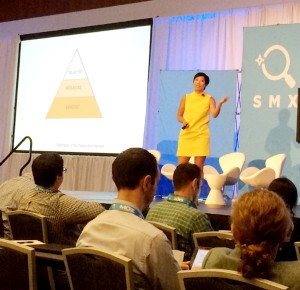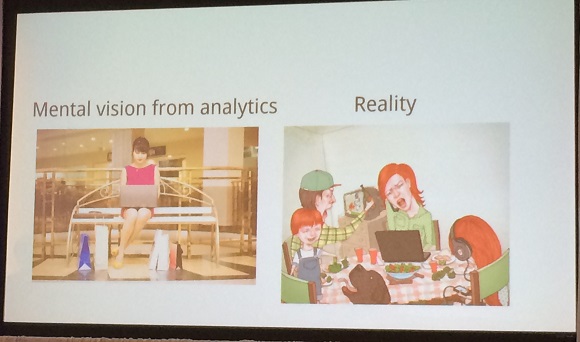Doing What Matters for SEO & Google in 2016 – Googler Maile Ohye at #SMX

A favorite Googler and SMX presenter, Maile Ohye, senior developer programs engineer at Google Inc. (@maileohye), explains that in 2004 and 2005, Matt Cutts used to say that search engines are chasing the user. In other words, the engine wants to serve the user first and then everything else (rankings, results pages) follow. A problem occurs when websites then chase the search engines.
An alternative view is when search engines and websites both chase the user, but this is oversimplified. Today she suggests a cultural shift to serve the customer, not the user.
So, we went from this:

To this:

“Humanity fuels the new economy.” — Seth Godin
- Create the extraordinary.
- Take risks. We need marketers that don’t ask for permission. Progress doesn’t happen by sticking to best practices — it happens when you create new practices and then better practices emerge.
- Do what matters. Don’t ask if you’re going to succeed, ask if you’re going to matter, because that’s what’s important.
Avinash Kaushik has created a new definition of conversion.
It used to be: conversion = orders / visits
Today it is: conversion = orders / visitors
It’s not about low-level clicks, sessions and page views. It’s about taking our thinking up to the person.
The offline experience is far ahead of the online world. Slice and dice the data as much as you can but remember that you’re optimizing for a local minimum.
Here’s Avinash’s new model of mapping data to customers:

The Ritz Carlton has a motto that we are ladies and gentlemen serving ladies and gentlemen. They have a three-tier level of service. Expected is clean linens and hot water. Requested is providing firmer pillows when asked. Delighted is above and beyond, like sewing a button when they notice it’s loose or combing a beach for lost sunglasses before they’re asked. Meet the needs people didn’t express, which are vast.
“Life is needs in action.” — Maile’s former acting coach
“Quantified data optimization doesn’t really address underlying needs.” — Maile Ohye
You may visualize your customer but until you talk to a real customer, you don’t know what their reality is.

The 2003 Google webmaster guidelines boiled down to 5 SEO instructions:
- Do something cool (compelling content or service).
- Include relevant keywords in your copy.
- Be smart about your tags and site architecture.
- Attract natural links.
- Stay fresh and relevant.
These principles hold true but the bar is much higher. Add to that — “for humans, do something cool.”
Smart cars, smart watches, the Echo — all these Internet of Things devices are new and evolving. There isn’t one market or device, there are multiple. 90% use multiple screens sequentially to accomplish a task over time. See if you can offer mobile website-only available code that works anywhere. Maybe you can come up with creative ways to estimate cross-device interactions.
Scanning is the new normal behavior. You don’t get a few sentences, you get a few words. 40% abandon if it takes more than 3 seconds to load.
Here are some things Google did to help customers:

They found people wanted new news front and center and support. See how now they start a blog post with a TL;DR instead of making it all about them?

Be smart about your tags and site architecture is still true today, but the tags are different now. Become AMP or structured-data ready. She gives an example of booking an appointment at a hair salon with Mio Mio Salon in San Francisco through Google because the salon has structured data markup.


Here’s an example of where things are going and how to be great — think in these terms first. In May 2015, Three Birds Nest was one of the top merchants on Etsy. In an interview, the founder said:
“Etsy was a great place for me to start because the market was there.”
“I didn’t have to pay for SEO from the start.”
“We want everything we touch, that our customer sees, to be something they connect with. That goes from our photography to how we interact with customers.”

2 Replies to “Doing What Matters for SEO & Google in 2016 – Googler Maile Ohye at #SMX”
Hi Virginia, this was my favorite session on Day One. This is a great summary. I was going through my own notes trying to remember all the points and missed some of these. I loved Maile’s breakdown of Expected, Requested, and Delighted. But I also loved her discussion of the offline vs online experience, and the point she made that “offline” marketers have been doing things longer than online and therefore it’s the online marketers that can learn some things from them! So glad you mentioned it, I had forgot about that before reading this. – Eric.
LEAVE A REPLY









